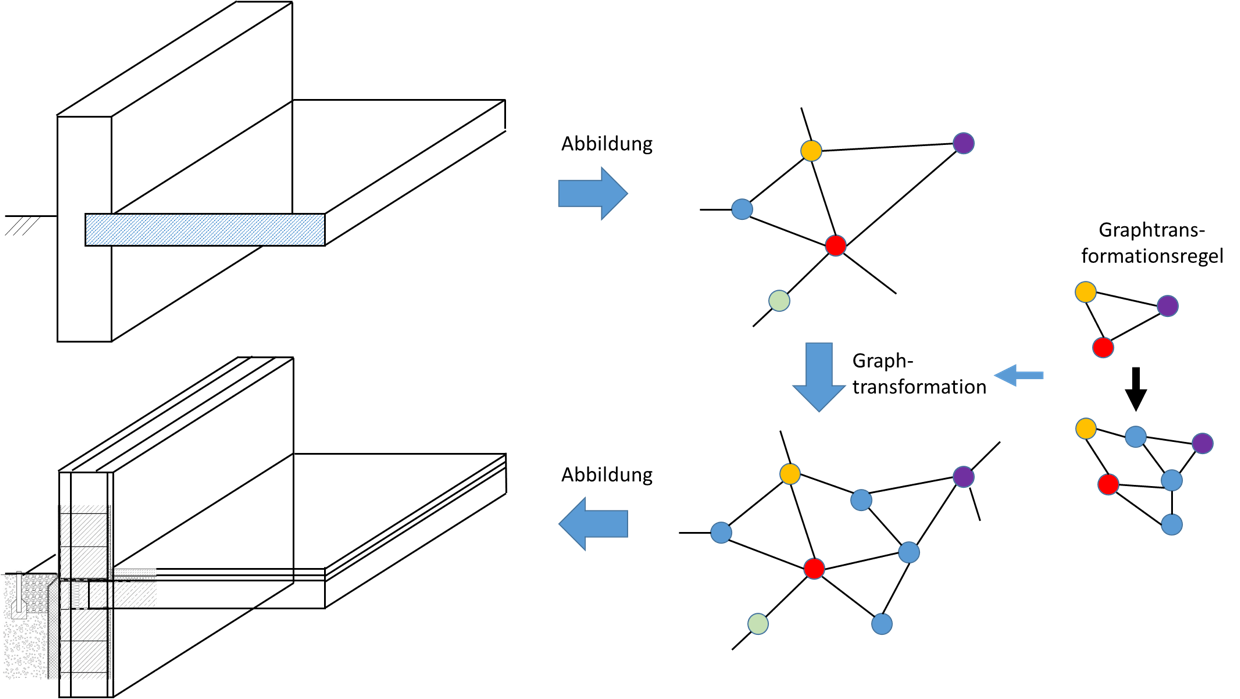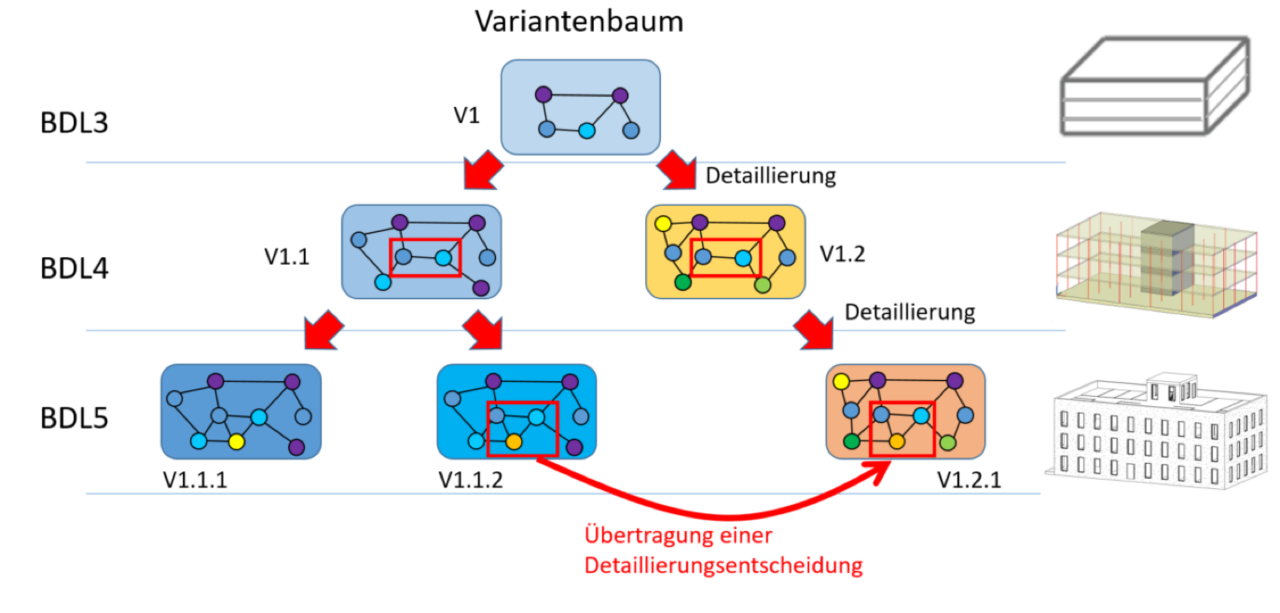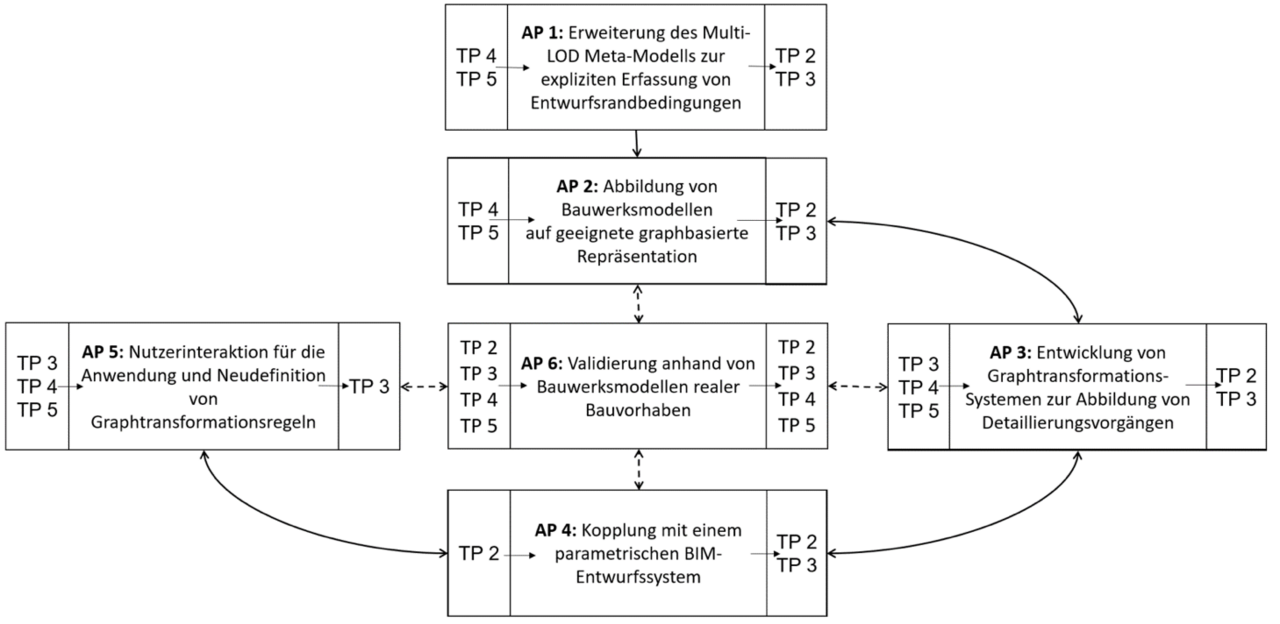Representation and transfer of detailing processes based on formal graph transformation systems
Team Members: Jimmy Abualdenien, André Borrmann
Funding: Deutsche Forschungsgemeinschaft (DFG), grant FOR 2363
Partners:
Running period: 09.2020-09.2023
Project description
The process of detailing plays an important role in the design process, as it involves (often implicit) design decisions that have a significant impact on the resulting building in terms of energy efficiency, usability, implementation costs, etc.
The chosen level of detailing correlates with the progress of the planning process; the fundamental decisions necessary at the beginning of the design process are represented by a correspondingly abstracted design, which is successively enriched with corresponding details. In the first phase of the subproject, the development of the meta-model for the formal specification of levels of detail provided an important basis for the support of detail-sensitive model-based planning. However, the question of how detailing decisions can be transferred between different design variants remains unsolved. However, this aspect is of crucial practical importance, since often one design variant is elaborated in detail, but later on, due to changed design boundary conditions, another variant has to be pursued and detailed again. In the course of the second phase of the subproject, therefore, possibilities are to be explored how processes of detailing can be formally recorded and flexibly transferred to alternative variants.
For this purpose, methods based on graph transformation systems are developed and their coupling with parametric design systems is investigated: The concept is that a graph represents a section of the building model at a certain level of detail and that the application of graph transformation rules manipulates this graph in such a way that it subsequently describes this section at a finer level of detail. In this way, it is possible to map detailing processes and the associated knowledge in a computer-interpretable manner and make it reusable. Complete automation is explicitly not intended; instead, the user is provided with a series of detailing rules from which he selects the most suitable one based on experience and context knowledge.
The methodology is to be developed generically and implemented exemplarily for a limited number of design entities and use cases. The prototypical implementation of the detailing functionality will be done by combining the graph transformation methodology with a parametric BIM system. For the realization of the project an intensive cooperation with the other subprojects is planned, among other things to procedures of decision support and documentation in the context of detailing, to the coordination of suitable graph representations, to the integration of simulation-relevant aspects in the field of energy and structure as well as to the subproject overlapping validation on the basis of the reference project.
Motivation
Designprozess in der Designphase
- die Detaillierung erfolgt schrittweise und iterativ
- mehrere Designvarianten werden untersucht und bewertet
- Detaillierung unterschiedlicher Varianten nach gleichem Muster -> aufwändig und fehleranfällig
Aktuelle modellbasierte Arbeiten (BIM), fehlend:
- formale Darstellung von Detaillierungswissen und Detaillierungsprozessen
- semi-automatische Übertragung von Detaillierungsprozessen zwischen Entwurfsvarianten
Wissenschaftliche Ziele
- Graph-basierte Repräsentation von Bauteilen und ihrer Einbettung in den topologisch-funktionalen Gebäudekontext
- Beschreibung von Detaillierungsvorgängen durch formale Graphtransformationen
- Entwicklung eines Konzepts zur Übertragung von Graphtransformationen zwischen verschiedenen Entwurfsvarianten
- Entwicklung von Möglichkeiten zur Definition formaler Detaillierungsregeln durch Endanwender
Arbeitsprogramm und Methoden
AP 1: Erweiterung des Multi-LOD Meta-Modells zur expliziten Erfassung von Entwurfsrandbedingungen
- Systematische Analyse der verschiedenen Constraint-Typen und ihrer Klassifikation
- Entwurfsrandbedingungen bzw. Gründe für Detaillierungsentscheidungen explizit im Meta-Modell
hinterlegen
AP 2: Abbildung von Bauwerksmodellen auf geeignete graphbasierte Repräsentation
- Verstärkt geometrische Abhängigkeiten zwischen Bauteilen berücksichtigen
- Unterschiedliche Formen der räumlich-topologischen Constraints berücksichtigen, um räumliche Konstellationen eineindeutig abzubilden

AP 3: Entwicklung von Graphtransformations-Systemen zur Abbildung von Detaillierungsvorgängen
- Graphtransformationsregeln zur Überführung eines Bauteils einer gröberen Detaillierungsstufe in eine feinere Detaillierungsstufe
- Nutzung und Erhalt der Parametrik von Bauteilen und des Gesamtbauwerks

AP 4: Kopplung mit einem parametrischen BIM-Entwurfssystem
- Kopplung des Graphersetzungssystems mit einem parametrischen BIM-Autorensystem
- Export- und Importmodule für die Graphrepräsentation
AP 5: Nutzerinteraktion für die Anwendung und Neudefinition von Graphtransformationsregeln
- Adäquate Interaktion mit dem graphbasierten Detaillierungssystem
- Definition von Detaillierungsregeln durch den Endnutzer
Zusammenarbeit
- Domänenspezifisches Fachwissen und Entwurfsrandbedingungen zur Anwendung von Detaillierungen werden von TP4 und TP5 beigesteuert
- Für die Ausarbeitung einer geeigneten Graphrepräsentation für die Beschreibung von Gebäudeentwürfen ist eine enge Zusammenarbeit mit TP2 vorgesehen
- Die Evaluierung des entwickelten Graphtransformationssystems wird gemeinsam mit TP2 und TP3 durchgeführt
- Die Ausarbeitung möglicher Formen der Nutzerinteraktion für die Definition von Graphtransformationsregeln wird durch eine enge Zusammenarbeit mit TP3, TP4 und TP5 realisiert



